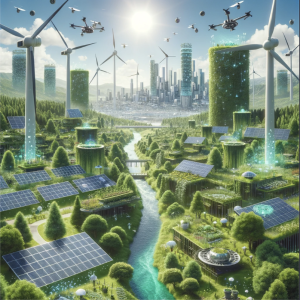Many articles today tend to focus on the downsides of AI, like its energy consumption, environmental impact, and the fear of it replacing humans. However, it’s time to shift this negative perspective and start paying more attention to and believing in the benefits and innovations that AI has to offer.
In the field of climate change, AI is not always seen as a solution, and the endless possibilities seem to be downplayed. Even when the capacity of modern technologies to optimize supply chains, or to reduce waste is recognised, discussions about these solutions remain broad and lack the specificity needed for actual proof it combats climate change. Therefor, this article presents multiple AI projects to implicate why AI carries an unfair stigma within the topic of climate change.
Take, for instance, the collaboration between Google, American Airlines, and Breakthrough Energy, that used AI to piece together and sift through satellite imagery, weather and flight path data. In this scenario, AI was used to create maps to forecast contrails, which are the white lines that can be seen behind airplanes. Contrails contribute to climate change by trapping more heat from the Earth than they reflect from the sun, resulting in a warming effect on the planet. They are only formed in certain parts of the atmosphere where the air is cold and wet, which are usually shallow areas. These AI-generated forecast maps made it possible to test if pilots can take routes that avoid creating contrails, by flying a little higher or a little lower. This optimization using AI, made it possible to cut down on contrails, which account for around 35% of the aviation sector’s global warming impact.

Another initiative came from scientist in California, who are using AI to fight wildfires. These fires immediately release carbon dioxide into the atmosphere, which negatively effects our climate. By connecting AI to cameras, the scientists were able to identify wildfires and detect smoke before they spread more widely. Even though some realistic modelling methodologies that suit the diversity in landscapes are still lacking, AI algorithms have shown impressive accuracy in predictions, and require only minimal detection time, compared to humans.
A big concern are the increasing global carbon emissions, and its effects on the climate. Fortunately, AI can provide a solution, with machine learning algorithms for precise analysis of companies’ energy usage, transportation, and manufacturing processes. This could lead to more accurate and faster modelling and measurement of companies their emissions. Based on these data and predictions, companies are able to pinpoint areas for improvement. In the transport sector there is a lot room for improvement, as it is responsible for roughly 25% of greenhouse gas emissions. There is already progress made by Google’s AI-focused DeepMind project, as they were able to reduce fuel consumption in vehicles by 15% while decreasing commuting times by analysing traffic data from sensors.
Besides reducing carbon emissions, there is also being experimented with capturing carbon from the atmosphere. AI could optimize this process by analysing environmental data, identifying the most effective capture methods and locations to ensure the most effective way for carbon reduction.
Apart from these projects, many startups are emerging to combat climate change by using innovative technological solutions. For example, Mortar IO, a startup company wanting to decrease the environmental impact of existing building, as they contribute 40% of the global carbon emissions. This is more than all cars, trains, and planes combined. By their implementation of AI, they allow organisations to gain a comprehensive understanding. This enables optimal decision-making and swift action for decarbonising entire building portfolios within minutes rather than months. Mortar IO speeds up the process to net zero for every building, and plays a great role in our fight against the climate.
A challenging subject, is the significant energy demands of AI systems. This makes the shift to renewable energy sources more essential to support the deployment of AI technologies. Renewable energy sources, such as solar and wind power, not only addresses the energy consumption of AI but also reduces our reliance on fossil fuels. The difficulty with renewable energy, is the unpredictability of natural factors. That’s where AI can also play a role, by helping with matching variable supply with rising and falling demand. This could maximise the financial value of renewable energy and allows it to be integrated into the grid more easily.
The argument that AI consumes too much energy, with the expectation of an increase in the future, is a valid concern, but it requires a nuanced perspective. Even though it is true that training AI models demands substantial computational power and energy, advancements in technology are leading to more efficiency. There is a trend toward developing more energy-efficient algorithms and hardware improvements that optimize energy usage for AI tasks. Moreover, the potential benefits of AI in optimizing various sectors, including energy efficiency itself, can offset its energy consumption. As the industry continues to evolve, researchers and engineers are now trying to find a balance between the capabilities of AI and its environmental impact. Therefore, suggesting that AI just consumes a lot of energy oversimplifies the ongoing efforts to make AI more energy-efficient.
Besides, we should have faith in new innovations and solutions, using the functionality of AI. Take, for example, the US government who is currently spending millions of dollars trying to recreate nuclear fusion, which is how the Sun gets its energy. If they succeed, it would create a limitless, green power supply.

While AI is often seen as a tool for efficient and effortless problem-solving in projects, the value of it should not be underestimated. The speed at which AI operates is exactly what we need in the urgency of our climate changing. While the energy consumption of AI optimizations might be a concern, the long-term positive impacts could outweigh these initial costs. As we address environmental challenges, unlocking the full power of AI can lead us to more sustainable and effective solutions.
In conclusion, the stigma around AI and its role in climate change needs a paradigm shift. Rather than being burdened by an unfair stigma, AI should be more recognised as a tool for innovation and positive change. Examples like the reduction of contrails and wildfires, decreased carbon emissions, and enhanced efficiency in renewable energy should serve as enough motivation for believing in its potential. Engineers and researchers using AI for environmental causes show the technology’s potential for a sustainable future. Let’s embrace AI’s transformative power in reshaping how we tackle climate challenges in our era.
References
(1) Chasan, A. (2023, 28 augustus). Some experts see AI as a tool against climate change. others say its own carbon footprint could be a problem. CBS News. https://www.cbsnews.com/news/artificial-intelligence-carbon-footprint-climate-change/
(2) Fire ecology. (2024, 26 januari). SpringerOpen. https://fireecology.springeropen.com/AIWFM#:~:text=Software%2Ddefined%20cameras%20(SDCs),efficient%20management%20of%20forest%20fires.
(3) Zhang, L., Ling, J., & Lin, M. (2022). Artificial Intelligence in Renewable Energy: A Comprehensive bibliometric analysis. Energy Reports, 8, 14072–14088. https://doi.org/10.1016/j.egyr.2022.10.347
(4) How artificial intelligence (AI) is driving decarbonisation. (2023, 5 december). Equans Group. https://www.equans.com/news/how-artificial-intelligence-is-driving-decarbonisation
(5) Why AI and energy are the new power couple – Analysis – IEA. (z.d.). IEA. https://www.iea.org/commentaries/why-ai-and-energy-are-the-new-power-couple
(6) Home | Mortar IO. (z.d.). Mortar IO. https://www.mapmortar.io/
(7) Elman, A. (2023, 8 mei). How 4 Startups are using AI to solve climate change challenges. Google. https://blog.google/outreach-initiatives/entrepreneurs/how-4-startups-are-using-ai-to-solve-climate-change-challenges/
(8) Wu, C. (2022, 22 april). Sustainable AI: environmental implications, challenges and opportunities. https://proceedings.mlsys.org/paper_files/paper/2022/hash/462211f67c7d858f663355eff93b745e-Abstract.html
(9) Vallance, B. Z. K. A. C. (2023, 10 oktober). Warning AI industry could use as much energy as the Netherlands. BBC News. https://www.bbc.com/news/technology-67053139
(10) DeGeurin, M. (2024, 18 januari). Sam Altman: Age of AI will require an ‘energy breakthrough’ Popular Science. https://www.popsci.com/technology/sam-altman-age-of-ai-will-require-an-energy-breakthrough/


